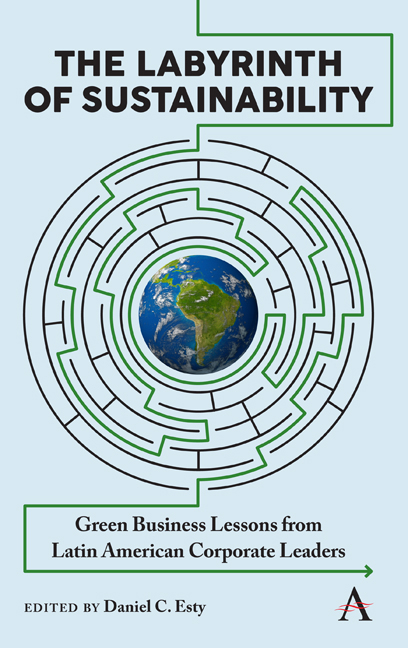Book contents
- Frontmatter
- Dedication
- Contents
- List of Illustrations
- Acknowledgments
- Notes on Contributors
- Introduction
- Chapter 1 Water Conservation in Scarcity Conditions: Corporate Sustainability at Mexico's FEMSA Group
- Chapter 2 Walmart Mexico: Clean Energy to Reduce Costs and Improve Corporate Image
- Chapter 3 Grupo Vanguardia Revitalizes Plastics Recycling in Honduras
- Chapter 4 Nissan Mexicana's Renewable Power Partnership
- Chapter 5 Tecnosol Follows the Sun
- Chapter 6 Rizek Pushes the Dominican Republic Cocoa Industry toward Sustainability
- Chapter 7 Centrosur Leads the Way to Sustainability in Ecuador
- Chapter 8 A Resilient World: Bavaria Builds Its Case on Water
- Chapter 9 Grupo Herdez Takes the Initiative in Mexico's Food Market
- Chapter 10 Chile's Las Palmas Avocado Orchard: Water Consumption Reduction in Agriculture
- Chapter 11 Mabesa: Increasing Global Competitiveness with Eco-friendly Disposable Products
- Chapter 12 Water Use Efficiency Initiatives in Nestlé's Value Chain and the Implications of the Company's Business Model
- Notes
- Index
Chapter 7 - Centrosur Leads the Way to Sustainability in Ecuador
Published online by Cambridge University Press: 29 May 2019
- Frontmatter
- Dedication
- Contents
- List of Illustrations
- Acknowledgments
- Notes on Contributors
- Introduction
- Chapter 1 Water Conservation in Scarcity Conditions: Corporate Sustainability at Mexico's FEMSA Group
- Chapter 2 Walmart Mexico: Clean Energy to Reduce Costs and Improve Corporate Image
- Chapter 3 Grupo Vanguardia Revitalizes Plastics Recycling in Honduras
- Chapter 4 Nissan Mexicana's Renewable Power Partnership
- Chapter 5 Tecnosol Follows the Sun
- Chapter 6 Rizek Pushes the Dominican Republic Cocoa Industry toward Sustainability
- Chapter 7 Centrosur Leads the Way to Sustainability in Ecuador
- Chapter 8 A Resilient World: Bavaria Builds Its Case on Water
- Chapter 9 Grupo Herdez Takes the Initiative in Mexico's Food Market
- Chapter 10 Chile's Las Palmas Avocado Orchard: Water Consumption Reduction in Agriculture
- Chapter 11 Mabesa: Increasing Global Competitiveness with Eco-friendly Disposable Products
- Chapter 12 Water Use Efficiency Initiatives in Nestlé's Value Chain and the Implications of the Company's Business Model
- Notes
- Index
Summary
Abstract
Utility companies in Ecuador are required to compile annual reports summarizing the environmental impacts of their operations. However, the Empresa Eléctrica Centro Sur C.A. (CENTROSUR), a government-owned electricity distributor, has taken this requirement a step further by being the first utility company in Ecuador to implement practices designed to reduce overall impact on the environment. By doing so, CENTROSUR demonstrates that sustainability is not just the company's responsibility, but also a business opportunity that could be embraced by other enterprises. This case study shows how CENTROSUR has been able to reduce its environmental impact through the implementation of an innovative recycling program called Sistema Integral de Manejo de Materiales, Equipos y Desechos Generados, better known by its acronym SIMED. Furthermore, this recycling program provides CENTROSUR with indicators that can be used to track the quantity of materials being reused, sold for scrap, or properly discarded. Each of these metrics has helped the company boost its bottom line. The SIMED program demonstrates the economic value of going beyond minimum regulatory requirements on environmental issues by generating over US$ million in revenue for CENTROSUR.
Introduction
CENTROSUR, a government-owned electric utility in southern Ecuador, has found ways to reduce the waste it generates on its projects. The company was founded in 1950 as the Empresa Eléctrica Miraflores S.A., a government-owned and -operated company (later renamed Empresa Eléctrica Centro Sur C.A. or CENTROSUR). It created and generated electricity until 1999, when Ecuador's Ministry of Energy mandated that the company focus solely on distribution. Today, the company is headquartered in Cuenca, the capital city of Azuay province, in southern Ecuador. CENTROSUR now supplies energy to Azuay, Morona-Santiago, and Cañar provinces, an area covering 23,759 square miles with a population of more than one million people according to the most recent census in 2010. With a yearly installation capacity of 1,018 gigawatt hours (GWh), the company serves 368,648 customers. Of these customers, 88 percent are households, 9 percent are commercial enterprises, and 2 percent are industrial users. As of 2015, the company had 476 full-time employees, 116 part-time staff, and annual revenues of US$106 million. All the electricity the company distributes is generated by hydroelectric power.
- Type
- Chapter
- Information
- The Labyrinth of SustainabilityGreen Business Lessons from Latin American Corporate Leaders, pp. 91 - 104Publisher: Anthem PressPrint publication year: 2019

